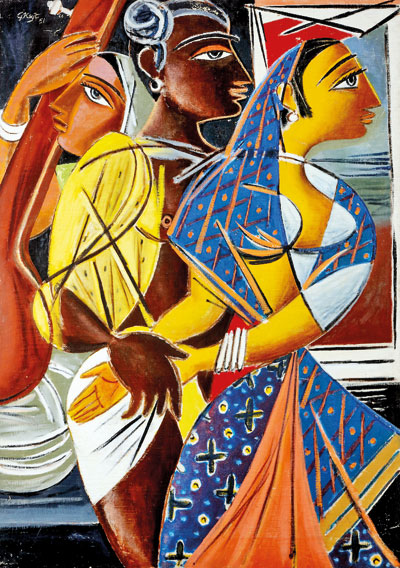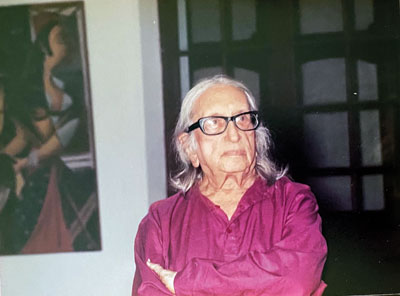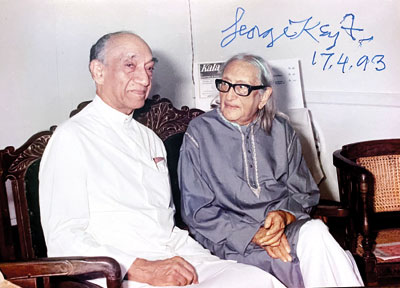Arts
The odyssey of George Keyt’s 21 paintings
View(s):- Shwetha Srikanthan & Malaka Talwatte trace the legacy of one of the country’s greatest artists
Born in Kandy, Sri Lanka, in April 1901, George Perceival Sproule Keyt (1901-1993) is one of Sri Lanka’s most renowned modernist painters, as well as a poet and writer. His work encapsulates a fluid synthesis of Eastern and Western, Buddhist and Hindu art and iconography. Keyt endures as Sri Lanka’s most celebrated artist and among the greatest Asian painters of the twentieth century. His extraordinary works have played a central role in the cultural heritage of Sri Lanka for over half a century and continue to do so to this day.
George Keyt’s earliest paintings belong to the mid-1920s, and it is estimated that in his lifetime he produced over 12,000 paintings, drawings and sketches, as well as the murals of significant cultural and historical value at the Gothami Viharaya Temple in Borella.
In June 1988, a group of his ardent admirers and close friends, headed by Cedric and Sita de Silva, established the George Keyt Foundation to perpetuate Keyt’s legacy and preserve his work as part of Sri Lanka’s cultural heritage. It was incorporated on June 13, 1990 as a legal entity and charitable trust, and Keyt himself witnessed its early years and significant contributions to the arts in Sri Lanka.

The famed 'Kangodi Ragini painting very nearly didn't return to Sri Lanka
A vast number of George Keyt’s paintings of the period 1926 to 1952 were taken to New Delhi in 1953 for an exhibition organised by the All India Fine Arts Society in association with the renowned Sri Lankan art collective, the ‘43 Group. The exhibition was thereafter transferred to Bombay, where disaster befell the artworks which were stored at the Victoria Warehouse when most of the paintings were destroyed and damaged in a fire.
The exhibition in Bombay did not take place as planned. The works that remained were then transported to London for the next exhibition by the Institute of Contemporary Art in London in January 1954. The exhibition was supplemented by a number of artworks from collections in London. Apart from a brief stop in Holland for an exhibition held in the same year by the Art Institute of Rotterdam, these paintings remained in London under the care of Keyt’s long-standing supporter and friend, Martin Russell.
In July 1988, upon the establishment of the George Keyt Foundation, Keyt decided to donate 21 of these paintings in London to the foundation as a nucleus for a proposed George Keyt Gallery. He requested Russell to send these 21 paintings he had entrusted to him to the foundation.
In a letter to Russell from Piliyandala in December 1988, as referenced in Buddha to Krishna: Life and Times of George Keyt by Yashodhara Dalmia (2016), Keyt wrote:
As I had donated my pictures to the foundation since they are making a gallery and you have with you some of the best of my work and since I now have no pictures in what was my own collection, and since very few people will be willing to donate from their collection; I naturally want you to send to Cedric de Silva … the pictures of mine with you.
In August 1989, Cedric de Silva circulated copies of two letters addressed to Martin Russell and Sri Lanka’s High Commissioner in the UK. The foundation had then informed Martin Russell to arrange for the 21 paintings to be handed over to Sri Lanka’s High Commissioner in London. With the assistance of the trustees of the George Keyt Foundation at the time –Cedric de Silva (Chairman), Justice Percy Colin-Thome (Vice-Chairman), Srimani Athulathmudali, Sam Elapata, Professor Ashley Halpe, Professor Cyril Ponnamperuma and Gilbert Sheinbaum – a public appeal was initiated on February 1, 1991. This ensured that the paintingswere successfully returned to Sri Lanka. With the support from Air Lanka, the Insurance Corporation of Sri Lanka, DHL International, and most importantly John Keells Holdings and its Chairman at the time Ken Balendra who spearheaded the campaign, the collection returned to the country in time for an exhibition celebrating George Keyt’s 90th birthday.

Keyt in front of 'Kangodi Ragini' at the Walkers Building
The 14 paintings and six drawings arrived at the Katunayake International Airport in Sri Lanka on an Air Lanka flight UL 504 from London Gatwick Airport on Monday, April 8, 1991. Of the 21 works originally donated, one was sold at the Patrick Searle Gallery in London prior to Keyt’s request to send the works back, and thus only 20 works returned to Sri Lanka. This could well have been 19, as one the most important paintings from the collection, ‘Kangodi Ragini’ (1951), was being sought by a wealthy London-based Middle-Eastern banker who was an avid collector of Keyt’s work. A request to enhance the initial offer was also heeded by the banker, but fortunately for the foundation, it was finally decided that this painting should remain part of the trust’s collection.
‘Kangodi Ragini’ (a mode in Indian music) is the largest painting in the George Keyt Foundation’s collection, and arguably one of its finest. The painting’s vivid colours and modernist figures are brilliantly representative of Keyt’s strokes of genius. All these 20 paintings were displayed at the Lionel Wendt Gallery in Colombo at a retrospective exhibition honouring George Keyt’s 90th birthday from April 17-21 1991.
As the George Keyt Foundation did not have a gallery to exhibit its collection of Keyt’s paintings at the time of its return to the island, Ken Balendra, the then Chairman of the Board of the John Keells Group, generously agreed to maintain the paintings and later housed them at their Glennie Street premises.
In 1992, the paintings were installed at the Walkers Tours Building of the John Keells Group. Given that only 20 of the originally bequeathed paintings were returned to Sri Lanka – Keyt graciously donated another painting, aptly named ‘The Friends’ (1982), to fill this void.
Unfortunately, after the John Keells Group had to shift its premises from Glennie Street due to a large-scale development project, a disaster occurred on July 12, 2013 as two masterpieces ‘Mother and Child’ (1953) and ‘Vasanti’ (1950), went missing. To this day, an investigation led by the Criminal Investigation Department of the Sri Lanka Police Service was unable to identify the perpetrators of this heinous crime. The foundation’s inaugural collection was reduced to 19 paintings and is now housed at John Keells head office, Colombo 2.

Keyt with president J.R. Jayewardene on his 90th birthday
These paintings of significant importance by George Keyt, which traversed an arduous journey to and from Sri Lanka, will continue to draw admirers of Keyt worldwide to the island and will continue to be a source of study and inspiration to local and regional artists, scholars and the wider public.
A further wish of the George Keyt Foundation is to create a sustainable viewing platform at the Gothami Viharaya Temple to make Keyt’s frescoes accessible to a wider public – reaffirming the foundation’s vision to perpetuate Keyt’s legacy and preserve his work as part of the country’s national heritage.
| A great supporter of Lankan art The year 1943 was a seminal one for Sri Lankan art as well as for George Keyt. When Lionel Wendt presented the 43 Group’s first exhibition in Colombo in November 1943, Martin Russell not only met George Keyt at the exhibition’s opening but was captivated by his work – a genius who had evolved his own stylistic vision – unlike anything Russell had previously encountered. Russell bought several of Keyt’s works and he continued to collect Sri Lankan paintings throughout his lifetime. From April 1995, in Martin Russell’s notes for Manel Fonseka about Lionel Wendt, referenced in Yashodhara Dalmia’s book, he writes: At that time I did not quite understand Keyt’s work, because it was so non-European, but another member of the ’43 Group, George Claessen, now living in London, pointed out to me that Keyt’s work had a ‘poetic’ quality. The word ‘poetic’ used by Claessen has been embedded in my memory ever since. I bought all the Keyts in the show, except one, The Journey, which I was told Lionel Wendt himself wanted to buy. In 1946, Russell returned briefly to England to begin writing his book The Art of George Keyt. This brilliantly illustrated monograph, which consisted largely of paintings from his own collection, was eventually published by Marg in Bombay in 1950. The book remains to this day the most comprehensive account of Keyt’s work. Martin Russell would go on to acquire the finest and unsurpassed collection of George Keyt’s work which accompanied him back to England for exhibitions and publicity and remained with him for several years. Russell continued to promote Sri Lankan art in London and was involved in setting up many exhibitions at galleries in London, Oxford, Cambridge and Paris. He was helpful to George Claessen and Ivan Peries of the ‘43 Group when they were working in London, offering patronage to the group and encouraging the exhibition of their work. Keyt first met Russell as a 42-year-old fully-fledged painter living in a village near Kandy, and would look upon Russell as his closest friend for over 40 years. Russell continued to be a great friend, patron and frequent visitor to Keyt and Menike’s home at Sirimalwatta, meeting often in the years between 1943 and 1953. Their closeness can be gauged from the fact that Keyt wrote to him frequently from Sri Lanka and turned to him during difficult times, particularly in his later years.
| |

